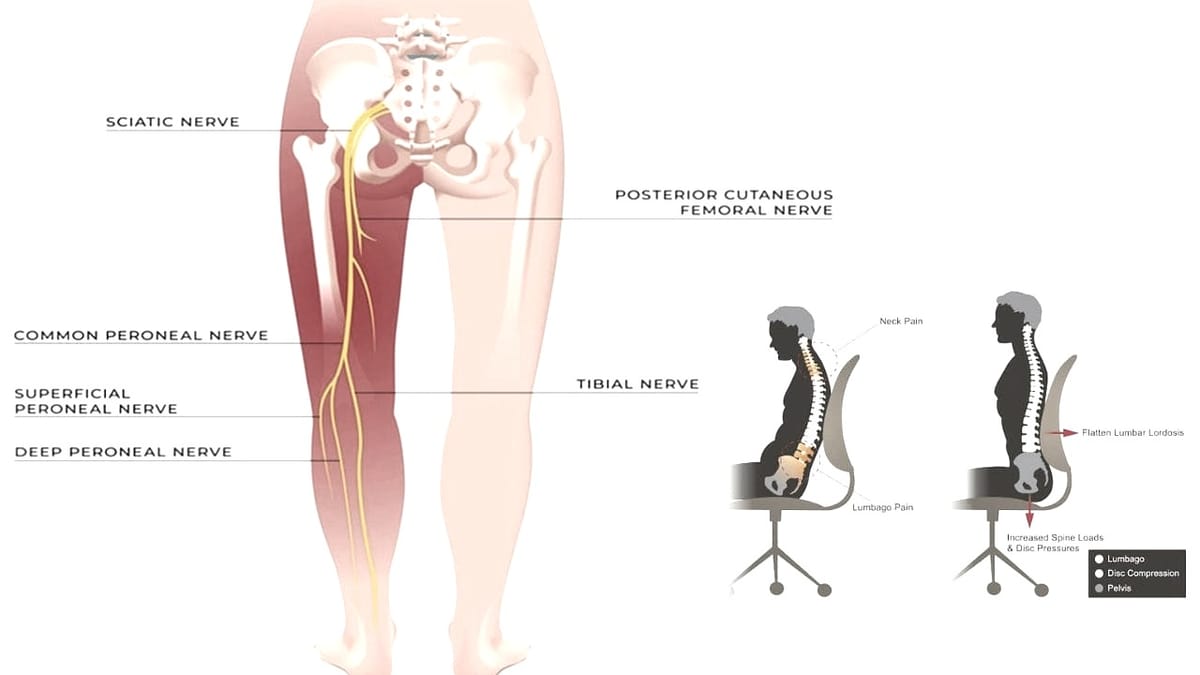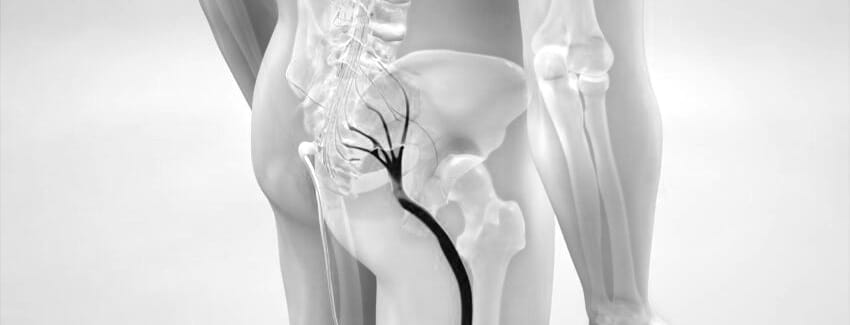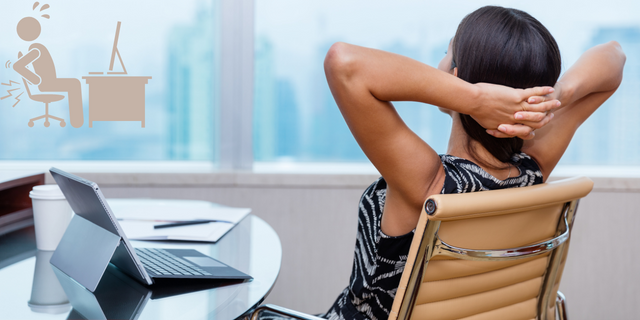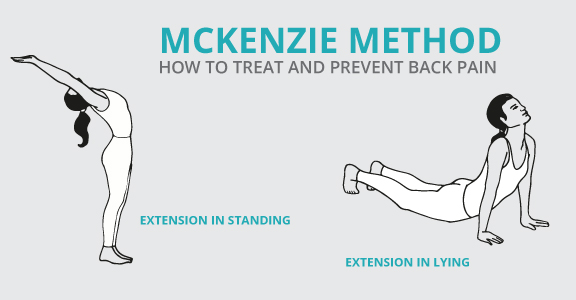Does Sitting Make Sciatica Worse? Unraveling the Impact
Sitting for prolonged periods can exacerbate sciatica symptoms, as the pressure on the sciatic nerve is intensified in a seated position.

Sciatica is a condition that can cause significant discomfort, often characterized by a sharp pain that radiates from the lower back down through the leg. This pain is the result of irritation or compression of the sciatic nerve, the longest nerve in the body.
For those who suffer from sciatica, finding relief is a top priority. One common question is whether sitting can exacerbate this condition. Let's delve into the relationship between sitting and sciatica, and explore ways to manage and potentially alleviate the pain.
Key Takeaways
- Prolonged sitting can increase the risk of sciatic nerve pain due to pressure on the lower lumbar discs.
- Ergonomic adjustments and regular movement breaks can help mitigate the negative effects of sitting on sciatica.
- Specific exercises and stretches can provide relief and prevent the worsening of sciatica symptoms.
Understanding Sciatica: A Brief Overview
Sciatica is often the result of a herniated disc, spinal stenosis, or piriformis syndrome, which can put pressure on the sciatic nerve. Symptoms can include pain, numbness, and tingling in the lower back, buttocks, and down the leg.
Sciatica can also be caused by a back injury, a ruptured disc, or a tight muscle. Because sciatica can be caused by a variety of conditions, the symptoms vary widely. Sciatica is a common condition, affecting an estimated 1 million Americans each year.
The Anatomy of Sitting: How It Affects Your Sciatic Nerve
When you sit, especially for prolonged periods, the lumbar discs are compressed. This compression can exacerbate underlying conditions that cause sciatica, leading to increased pain and discomfort.

Poor posture while sitting can further irritate the sciatic nerve. Slouching or sitting without proper back support can increase the strain on your spine and the sciatic nerve. The longer you sit, the more you increase your risk of sciatica pain.
Ergonomics and Sciatica: Creating a Sciatica-Friendly Workspace
An ergonomic workspace can help reduce the pressure on your sciatic nerve. Adjustable chairs, standing desks, and monitor risers can all contribute to a more sciatica-friendly sitting environment.

The Importance of Movement: Combating the Sedentary Lifestyle
Regular movement is crucial for those with sciatica. Taking short breaks to walk or stretch can alleviate nerve pressure and improve symptoms.
Stretching: A Key Tool in Managing Sciatica
Specific stretches targeting the lower back and legs can help relieve sciatic nerve compression. Gentle yoga or pilates can be particularly beneficial.
Exercise and Sciatica: Building Strength and Flexibility
Regular exercise can strengthen the muscles supporting the spine, reducing the likelihood of sciatica flare-ups. Low-impact activities like swimming or cycling are often recommended.
Studies have shown that prolonged sitting can lead to increased back pain and sciatica symptoms. Understanding this research can help in managing the condition.
Sciatica and the Office Worker: Strategies for Relief
Office workers are particularly at risk for sciatica due to long hours of sitting. Implementing ergonomic solutions and movement strategies can be especially important for this group.
Maintaining sciatic nerve health involves managing sitting habits. This includes using proper support and taking frequent breaks to stretch and move. If you have experienced sciatica symptoms try basic remedies first to see the impact. If symptoms persist, seek medical attention to determine the cause and receive treatment.
Tailoring Your Sitting Habits to Alleviate Sciatica
Adjusting how you sit can make a significant difference in sciatica pain levels. This involves using ergonomic aids and being mindful of posture.
Sciatica-Friendly Seating Options: What to Look For
Choosing the right chair can help reduce sciatica symptoms. Look for options with lumbar support, adjustable height, and a comfortable seat cushion.
The Role of Seat Cushions in Sciatica Management
Specialized seat cushions can distribute weight evenly and reduce pressure on the sciatic nerve. Memory foam and coccyx cut-out cushions are popular choices.
Standing Desks: A Viable Solution for Sciatica Sufferers?
Standing desks can provide an alternative to sitting and may help some individuals manage their sciatica symptoms more effectively.
Break Time: Integrating Movement into Your Workday
Setting reminders to take regular breaks for movement can prevent stiffness and reduce sciatic nerve compression. Certain exercises, such as the McKenzie Method or gentle stretching, can be particularly effective for sciatica sufferers.

When to See a Professional
If sciatica symptoms persist or worsen, it's important to seek medical advice. A healthcare professional can provide tailored recommendations and treatment options.
There are many misconceptions about sciatica and sitting. Understanding the facts can help in managing the condition more effectively.
Misconceptions about sciatica and sitting abound, often leading individuals down a path of unnecessary discomfort. One prevalent fallacy suggests that sitting exacerbates sciatic pain, prompting some to adopt a perpetual standing posture.
Contrary to this belief, sitting is not inherently harmful; rather, it's the prolonged, improper sitting positions that contribute to discomfort.
Another misconception is the idea that complete rest is the remedy for sciatica. In reality, gentle movement and targeted exercises can often alleviate symptoms.
It's crucial to debunk these myths, emphasizing the importance of ergonomic seating, regular breaks, and mindful exercises to foster a balanced approach to managing sciatic discomfort and promoting overall spinal health.
Long-Term Strategies for Living with Sciatica
Managing sciatica is often about long-term lifestyle changes. This includes regular exercise, proper ergonomics, and movement habits.
Living with sciatica requires a multifaceted approach that extends beyond immediate relief to encompass long-term strategies promoting overall well-being. Consistent exercise tailored to strengthen the core muscles, improve flexibility, and enhance posture can be pivotal in managing and preventing sciatic pain.
Developing a mindfulness practice, such as yoga or meditation, aids in stress reduction, which can alleviate tension contributing to sciatica. Ergonomic adjustments in daily activities and workspace can mitigate strain on the spine.
Moreover, cultivating a healthy lifestyle through proper nutrition and regular sleep fosters an environment conducive to healing. Integrating these long-term strategies empowers individuals to proactively manage sciatica, fostering a sustainable and resilient foundation for a pain-free life.
Summary
Sitting for extended periods can indeed make sciatica worse by increasing pressure on the lumbar discs and the sciatic nerve. However, by adopting proper sitting habits, utilizing ergonomic tools, and incorporating regular movement and exercises into your routine, you can manage and potentially alleviate sciatica symptoms. Remember, it's important to consult with a healthcare professional for personalized advice and treatment.
FAQs
Q: Can sitting cause sciatica to flare up?
A: Yes, sitting for prolonged periods can cause sciatica to flare up or worsen. Sciatica occurs when the sciatic nerve, which runs from the lower back through the hips and down each leg, becomes irritated or compressed. Sitting, especially in poor posture, can place additional pressure on the lower back and hips, aggravating the nerve. Here’s a breakdown of why sitting impacts sciatica and what you can do to alleviate it:
Why Sitting Can Trigger Sciatica
- Increased Pressure on the Sciatic Nerve:
Sitting compresses the lower spine and pelvic area, which can aggravate the sciatic nerve, particularly if the nerve is already inflamed or pinched. - Poor Posture:
Slouching or sitting with improper alignment can worsen the pressure on your lumbar spine (lower back) and contribute to sciatica pain. - Lack of Movement:
Sitting for long stretches reduces blood circulation and muscle flexibility, which can lead to stiffness and irritation of the sciatic nerve. - Tight Hip Muscles:
Prolonged sitting can cause the piriformis muscle (a small muscle in the buttocks) to tighten. If this muscle compresses the sciatic nerve (a condition known as piriformis syndrome), it can trigger sciatica symptoms.
Signs That Sitting is Worsening Sciatica
- Sharp or shooting pain down one leg.
- Tingling, numbness, or weakness in the leg or foot.
- Pain that intensifies after prolonged sitting or when getting up from a chair.
Tips to Prevent or Manage Sciatica Flare-Ups While Sitting
- Use Proper Posture:
Sit with your back straight, shoulders relaxed, and both feet flat on the floor. Avoid crossing your legs, as it can worsen pelvic misalignment. - Choose the Right Chair:
Use an ergonomic chair with lumbar support to reduce strain on your lower back. Alternatively, you can use a coccyx cushion or lumbar roll for additional support. - Take Frequent Breaks:
Stand up, stretch, and walk around every 30–60 minutes to reduce pressure on the sciatic nerve. - Stretch Regularly:
Incorporate gentle stretches like hamstring stretches, hip openers, or the seated piriformis stretch to relieve tension around the sciatic nerve. - Apply Heat or Ice:
Use a heating pad or ice pack on your lower back to reduce inflammation and ease discomfort. - Strengthen Core Muscles:
A strong core helps support your spine and reduces the risk of further sciatic nerve compression.
When to Seek Medical Advice
If your sciatica symptoms persist, worsen, or severely limit your mobility, it’s important to consult a healthcare professional. Chronic sciatica might require additional treatments such as physical therapy, medications, or in rare cases, surgery.
Sitting can indeed trigger or worsen sciatica symptoms, especially if your posture is poor or you remain seated for long periods. Taking proactive steps like maintaining good posture, using ergonomic seating, and incorporating regular movement into your routine can help minimize flare-ups. If you’re struggling to manage your symptoms, seek professional guidance to develop a personalized treatment plan.
Q: What are some ergonomic adjustments I can make to help with sciatica?
A: Sciatica, characterized by pain that radiates along the sciatic nerve, often due to a herniated disk, spinal stenosis, or muscle compression, can be exacerbated by poor posture and improper ergonomics. Making adjustments to your workstation, seating, and daily habits can help alleviate pressure on the sciatic nerve and reduce discomfort. Here are some ergonomic adjustments to consider:
1. Optimize Your Desk Setup
- Chair Selection: Use a chair with good lumbar support to maintain the natural curve of your spine. Ideally, your feet should be flat on the floor, with your knees at a 90-degree angle.
- Desk Height: Ensure that your desk is at a height where your elbows are at a 90-degree angle when typing. This helps maintain proper posture and avoids putting additional pressure on the lower back.
- Monitor Position: Position your monitor at eye level, so you don't have to strain your neck or hunch forward. The top of the screen should be roughly at or slightly below eye level.
2. Use an Ergonomic Chair Cushion
If your chair doesn’t provide adequate lumbar support or comfort, consider investing in an ergonomic cushion. A seat cushion designed for sciatic pain can help evenly distribute your body weight and alleviate pressure on the spine, especially if you sit for long periods.
3. Take Regular Breaks
Sitting for extended periods can worsen sciatica. Stand, stretch, and walk around every 30-60 minutes to relieve pressure on your lower back. Consider using a standing desk to alternate between sitting and standing throughout the day.
4. Mind Your Posture
Maintain a neutral spine position, whether sitting or standing. Avoid slouching or leaning forward, as this places extra pressure on the lower back and can irritate the sciatic nerve. When standing, keep your weight evenly distributed between both legs and avoid locking your knees.
5. Adjust Your Driving Position
If you drive often, adjust the seat to ensure your knees are level with your hips, and the seat back provides adequate lower back support. Avoid sitting too upright or too reclined, as both positions can put strain on the back and aggravate sciatica.
6. Use Proper Lifting Techniques
When lifting objects, bend at your hips and knees, not your back. Keep the object close to your body and avoid twisting your torso, which can strain the lower back and worsen sciatica.
7. Strengthen Core Muscles
A strong core supports your spine and reduces strain on your back muscles. Incorporating core-strengthening exercises into your routine can help stabilize the spine and reduce sciatica symptoms over time.
By making these ergonomic adjustments, you can create a more supportive environment for your body and relieve some of the pressure that causes sciatic pain. Always consult with a healthcare provider for personalized advice and to ensure you're addressing any underlying conditions contributing to your sciatica.
Q: Are there specific exercises that can help relieve sciatica pain?
A: Yes, specific exercises can help relieve sciatica pain by targeting the muscles that affect the sciatic nerve and promoting flexibility, strength, and proper alignment. Sciatica occurs when the sciatic nerve, which runs from the lower back through the hips and down each leg, becomes irritated or compressed. This leads to pain, tingling, or numbness along the nerve path. Fortunately, exercises that focus on stretching and strengthening the muscles around the lower back, hips, and legs can help alleviate pressure on the sciatic nerve.
Here are some effective exercises for relieving sciatica pain:
1. Pelvic Tilts
Pelvic tilts help strengthen the muscles of your lower back and abdomen, which support the spine. This exercise can reduce tension and relieve pressure on the sciatic nerve.
How to Do It:
- Lie on your back with your knees bent and feet flat on the floor.
- Tighten your abdominal muscles and tilt your pelvis upward.
- Hold for 5 seconds, then relax.
- Repeat 10-15 times.
2. Knee to Chest Stretch
This stretch targets the lower back and glutes, which can ease tightness and reduce sciatic nerve irritation.
How to Do It:
- Lie on your back with your knees bent.
- Bring one knee toward your chest while keeping the other foot flat on the floor.
- Hold for 20-30 seconds, then switch legs.
- Repeat 2-3 times for each leg.
3. Cat-Cow Stretch
The cat-cow stretch improves flexibility and relieves tension in your spine, helping to reduce sciatic pain.
How to Do It:
- Start on your hands and knees with your wrists aligned under your shoulders and your knees under your hips.
- Inhale and arch your back, letting your belly drop (cow position).
- Exhale and round your back, tucking your chin to your chest (cat position).
- Repeat for 10-15 rounds.
4. Seated Piriformis Stretch
This stretch targets the piriformis muscle, which can irritate the sciatic nerve when tight.
How to Do It:
- Sit on the floor with one leg extended and the other bent so that the ankle rests on the knee of the extended leg.
- Gently lean forward to stretch the glutes and hips.
- Hold for 20-30 seconds and repeat on the other side.
5. Bridge Exercise
Bridges strengthen the glutes and lower back muscles, which can help relieve pressure on the sciatic nerve.
How to Do It:
- Lie on your back with your knees bent and feet flat on the floor.
- Tighten your glutes and lift your hips off the floor until your shoulders, hips, and knees are in a straight line.
- Hold for 5-10 seconds, then lower back down.
- Repeat 10-15 times.
6. Hamstring Stretch
Tight hamstrings can exacerbate sciatica pain, so stretching them regularly can provide relief.
How to Do It:
- Lie on your back with one leg extended straight.
- Use a towel or resistance band around the ball of your foot to gently pull your leg toward you.
- Hold for 20-30 seconds, then switch legs.
7. Standing Hamstring Stretch
This stretch targets the hamstrings while keeping your back straight, preventing further strain.
How to Do It:
- Stand with your feet hip-width apart.
- Step one foot forward and keep your heel on the ground while slightly bending your back leg.
- Reach for your toes on the extended leg.
- Hold for 20-30 seconds and repeat on the other side.
8. Walking or Swimming
Low-impact activities like walking and swimming can promote blood flow, ease stiffness, and prevent the muscles from becoming tight.
Tips to Keep in Mind:
- Start Slowly: If you're new to exercise or experiencing significant pain, start with gentle stretches and gradually progress as your body adapts.
- Avoid Overstretching: Never push yourself too hard, as overstretching can worsen sciatica symptoms.
- Consult a Healthcare Provider: Always check with your doctor or physical therapist before starting any exercise routine, especially if your sciatica pain is severe or persistent.
Conclusion:
Sciatica pain can often be alleviated with specific exercises that focus on improving flexibility, strengthening muscles, and reducing pressure on the sciatic nerve. Consistency is key, and with the right approach, exercises can help you manage or even prevent sciatica pain.

It's best to consult with a physical therapist for a personalized exercise plan.
